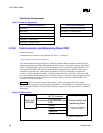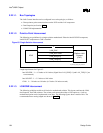
Intel
®
820E Chipset
R
98 Design Guide
2.19.3. RTC Layout Considerations
• Minimize the RTC lead lengths. Approximately 0.25 inch is sufficient.
• Minimize the capacitance between Xin and Xout in the routing.
• Put a ground plane under the XTAL components.
• Do not route switching signals under the external components (unless on the other side of the
board).
• The oscillator V
CC
should be clean. Use a filter (e.g., an RC low-pass) or a ferrite inductor.
2.19.4. RTC External Battery Connection
The RTC requires an external battery connection to maintain its functionality and its RAM while the
ICH2 is not powered by the system.
Example batteries are the Duracell* 2032, 2025 or 2016 (or equivalent), which provide many years of
operation. Batteries are rated by storage capacity. The battery life can be calculated by dividing the
capacity by the average current required. For example, if the battery storage capacity is 170 mAh
(assumed usable) and the average current required is 3 µA, the battery life will be at least:
170,000 µAh / 3 µA = 56,666 h = 6.4 years
The battery voltage can affect the RTC accuracy. In general, when the battery voltage decays, the RTC
accuracy also decreases. High accuracy can be obtained when the RTC voltage is within the range 3.0 V
to 3.3 V.
The battery must be connected to the ICH2 via an isolation Schottky diode circuit. The Schottky diode
circuit allows the ICH2 RTC well to be powered by the battery when system power is unavailable, but by
system power when it is available. For this purpose, the diodes are set to be reverse-biased when system
power is unavailable. The following figure is an example diode circuit.
Figure 60. Diode Circuit Connecting RTC External Battery
VCC3_3SBY
VccRTC
1.0 µF
1 k
Ω
RTC_ext_batt_diode_cir
c
-
+


















